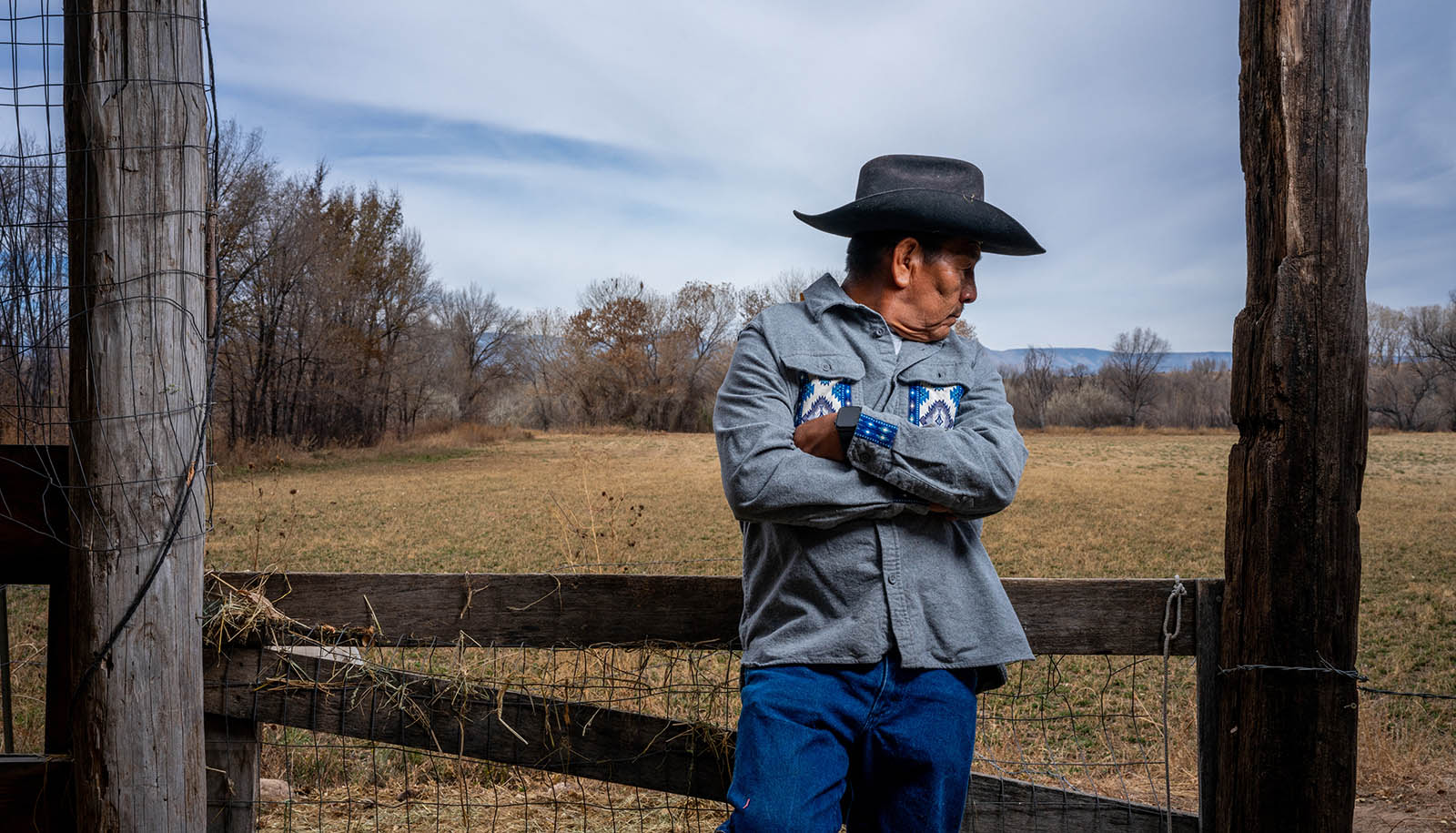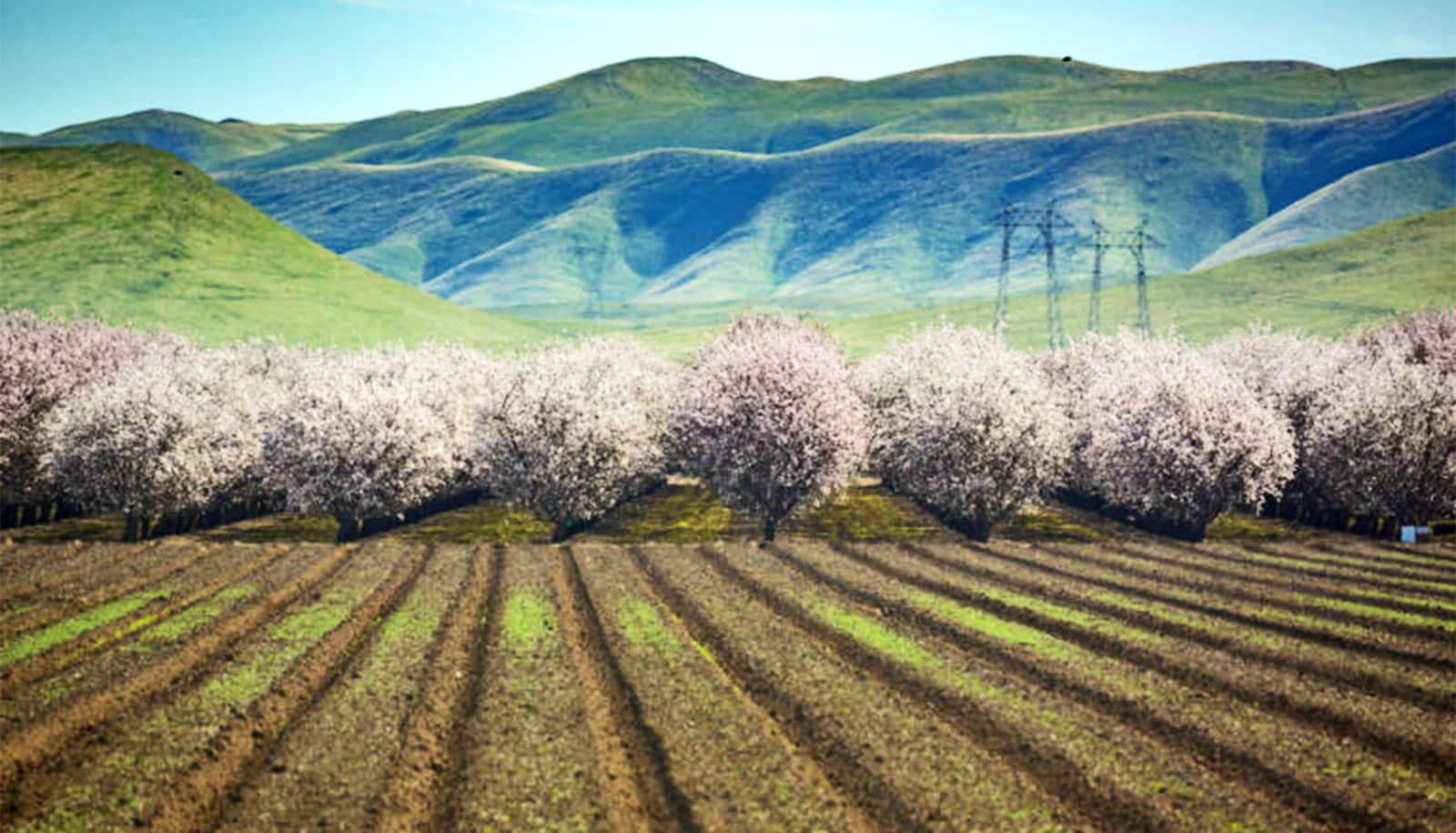
Joseph Patrick Aguino, 69, in Ohkay Owingeh, New Mexico. In an effort to preserve the language and culture, Aguino of the Ohkay Owingeh Pueblo began teaching the Tewa language after his daughter passed away in 1999. The Pueblo Native Americans continue working to preserve their culture and language under a shifting landscape severely impacted by drought and irregular weather extremes. (Credit: Brandon Bell/Getty Images )
Rising temps challenge Southwest farmers, ranchers
Rising temperatures brought on by human-driven atmospheric warming are bringing big changes to agricultural life in the Southwest, research indicates.
The rising temperatures brought on by human-driven atmospheric warming are bringing big changes to agricultural life in the Southwest, research indicates.
“Increased temperatures from human-caused climate change are having persistent and damaging impacts on vegetation productivity, with significant implications for ranchers and other land users in the region,” write researchers in a recent paper.
The American Southwest has always been a dry place—cue the romantic visions of hot, rugged, sun-bleached, seemingly infinite landscapes and star-filled night skies. And yet, the plants, animals, and people of the Four Corners region (Utah, Colorado, New Mexico, and Arizona) have managed to adapt to and even flourish in the land of low rainfall and high temperatures. Long before the arrival of Spanish settlers to the region in the 1500s, Indigenous Puebloan communities practiced agriculture that is uniquely suited to and thus thrived in this dry environment. When the Spanish introduced cattle and other livestock, available forage was found suitable and abundant enough for grazing, leading to a dominance of ranching in the region.
“…tribal communities, who have lived here for generations in relative balance with the land, are now uniquely vulnerable and have moreover done the least to contribute to human-driven climate change.”
“There are climate extremes that are tied to too much rainfall or too little rainfall,” says University of California, Santa Barbara climate scientist Chris Funk, coauthor of the research article in Earth’s Future . “What this work has really focused on is a different and equally dangerous type of climate change that is associated with the desiccation of plants by extreme temperatures .”
On top of a two-decade ongoing megadrought, the researchers found that rising average air temperatures are extending conditions that increase evaporation from leaves, exacerbating the impact of declining precipitation. The result? A decrease in vegetation to support life on the range.
The ability of air to hold water (as vapor) is central to their findings, according to Funk, who leads the university’s Climate Hazards Center.
“For every degree Celsius of warming, the amount of water vapor the air can hold goes up by about 7% because the hydrogen and oxygen atoms in the air are bouncing around more,” he said. “So there’s more space in between them and that can hold more water.” Ironically, he adds, that increased capacity can lead to more extreme floods when the saturation tipping point is reached because there’s more water in the atmosphere to rain out.
But the atmosphere’s increased ability to hold water also amplifies dry seasons, drawing water out of vegetation to satisfy the increased demand for moisture in the warmer air. This difference in the amount of water in the air and how much it can hold to saturation is called a vapor pressure deficit (VPD).
“There are three major impacts of this deficit on the landscape,” Funk explains. “One would be less productive crops. Another, which is the one we focused on, is rangeland productivity—pasture health. And the third is wildfire extent and low dead fuel moisture levels.” Over the last century, according to the US Environmental Protection Agency, average temperatures across the entire Southwest, with California and Nevada in addition to the Four Corners states, have increased by up to 2°F (1.1°C).
And it shows. In the Four Corners region, the researchers note a big decrease in the amount of green vegetation in 2020. They estimate that about half of that decrease was due to the impact of rising air temperatures.
It’s not only plants and the animals that depend on them that are being affected. Farming and ranching communities, and in particular Indigenous communities in the Southwest who rely heavily on the vegetation may have to resort to purchasing fodder—the prices for which could be impacted by the abnormally dry weather.
“The reality is that these vapor pressure deficits, though they seem intangible, are leading to real-life impacts for people, such as inadequate water or poor forage,” says lead author Emily Williams, who completed this work as a doctoral student at UC Santa Barbara before moving to UC Merced for postdoctoral research. “And many of the people most impacted, like tribal communities, who have lived here for generations in relative balance with the land, are now uniquely vulnerable and have moreover done the least to contribute to human-driven climate change.”
Despite an El Niño system that is predicted to bring more rain to the Southwest this winter, the Four Corners region is likely to remain parched, Funk says.
“First, ‘Southwest’ and Four Corners can be quite different,” he says. ” The link between the Four Corners summer monsoon and the El Niño Southern Oscillation is weak.” The recent summer monsoon was inadequate in terms of the moisture it brought to the areas, he adds, and the abnormal heat, especially across Colorado, New Mexico and Arizona, have amplified the VPD effects.
“So, while El Niño can increase winter rains across parts of the Southwest, it can also increase air temperature and VPD,” he explains. “The latter effect, combined with a poor summer monsoon, means that Arizona and especially New Mexico, are still in serious drought.”
“Many of the people most impacted, like tribal communities, who have lived here for generations in relative balance with the land, are now uniquely vulnerable and have moreover done the least to contribute to human-driven climate change.”
The results of this study, the researchers say, may be applicable to other regions in the world with an arid or semi-arid climate. Funk and colleagues at the Climate Hazards Center are rapidly advancing their climate prediction capabilities by understanding the roles and impacts of vapor pressure deficits during the alternating El Niño and La Niña weather systems, each of which bring different temperatures and the likelihood of different weather events. Ironically, climate-change enhanced moisture convergence over the Pacific is enhancing the strength of La Niñas. With better predictions, it may become possible to anticipate and adjust to the impacts of drought and other heat-driven events in the future.
Source: UC Santa Barbara
The post Rising temps challenge Southwest farmers, ranchers appeared first on Futurity .
Share this article:
This article uses material from the Futurity article, and is licenced under a CC BY-SA 4.0 International License. Images, videos and audio are available under their respective licenses.
Related Articles:
California’s strict air pollution laws are good for farmers
March 18, 2020 • futurityVoter poll: 11% of Republicans say climate is a crisis
Dec. 20, 2019 • futurityLinks/images:
- https://doi.org/10.1029/2022EF002943
- https://www.futurity.org/agricultural-workers-extreme-heat-2770562-2/
- https://www.futurity.org/poverty-sustainability-2833602/
- https://news.ucsb.edu/2023/021269/farmers-and-ranchers-southwestern-us-face-challenges-due-human-induced-atmospheric
- https://www.futurity.org/southwest-agriculture-climate-change-3007702-2/
- https://www.futurity.org


